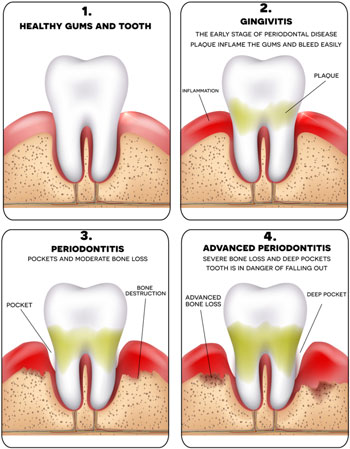Gum Disease Symptoms, Gingival Recession Treatment Procedure
Reviewed June 2024 by Our Content Experts
What Is Gingivitis?
Gingivitis is a common form of gum disease that causes inflammation of the gums (gingiva) as a result of bacterial growth. The first sign of gingivitis is having blood on your toothbrush or dental floss. If left untreated, gingivitis can lead periodontal disease.
Gum disease is easily prevented and treated if detected early. If ignored, gum disease can lead to more serious health issues. Beyond causing painful, swollen, bleeding gums and bad breath, if left untreated, periodontal disease can result in irreversible bone damage and tooth loss.

How Much Does Treating Gingivitis Cost?
The cost of gum disease treatment will depend on the severity of your condition. Based on data from the Australian Dental Association, a root scale and planing (item 011, 114, 121, 221, 222x4) can cost up to $981. With Smile dental cover, you get reduced and capped dental fees on gingivitis treatments.

Top-rated dental cover in Australia!


How Do Dentists Treat Gingivitis?
Gum disease treatment is aimed at controlling the existing infection and stopping it from progressing. There are several different professional gum disease treatments available, such as scaling and root planing, curettage, flap surgery, and bone grafts.
Scaling and Root Planing
If your Smile dentist finds that there is some bone loss or that your gums are receding, your dentist may recommend a very common, rigorous, deep-cleaning and non-surgical method known as scaling and root planing (SRP).
Scaling treatment involves scraping the plaque and tartar away from below and above the gum line. Root planing treatment smooths uneven spots on the tooth root where bacteria accumulates. This smooth and clean surface assists the gums in reattaching to the teeth.
The benefits of scaling and root planing treatment include:
- Stops gum disease becoming worse
- Prevents tooth loss
- Nips tooth decay in the bud
- Protects the roots of your teeth
- Reduces bad breath
Curettage
The dental treatment called curettage consists of scraping away unhealthy gum tissue from the infected area and then allowing it to heal. It uses a small hand held tool called a curette. Antibiotics may be prescribed following treatment.
There are two types of curettage:
- Gingival curettage
- Subgingival curettage
Flap Surgery
Gingival flap surgery is a procedure that allows your Smile dentist to reach the root of your tooth and bone. Flap surgery is recommended for people who experience mild to advanced periodontitis. Flap surgery is usually performed if a non-surgical treatment, such as scaling and root planing, is ineffective at removing the gum infection.
For a flap surgery procedure, your dentist will lift the gums away and remove the tartar as needed. They will then sew the gums back in position so the tissue fits firmly around the teeth. This procedure also decreases the size of the pocket, giving bacteria less room to grow back.
You may experience some discomfort following flap surgery treatment, which can often be alleviated with over-the-counter pain relief medication. You may also experience minimal bleeding and swelling, however this can be reduced by applying an ice pack to the swollen area. Your dentist may prescribe antibiotics to avoid the possibility of an infection.
Bone Grafts
If your bone has been damaged due to periodontitis, bone grafts will be used to replace it. For a bone graft procedure, small pieces of bone (either your own, donated or synthetic) will be positioned where the original bone was eroded. These grafts work as a platform for the bone to regrow from as well as restoring stability to your teeth.
Successful bone grafts can also reinforce the strength of your jaw bone so it can support a dental implant.
What Causes Gingivitis?
Gingivitis is caused by bacterial growth, which occurs when a build-up of plaque has not been removed by thorough daily brushing and flossing. This plaque forms tartar which destroys the tissue that surrounds and supports your teeth.
You can prevent damage caused by gingivitis by maintaining proper oral hygiene habits, such as daily brushing and flossing.
Is It Necessary To Treat Gingivitis?
Yes, you do need to treat gingivitis. If left untreated, gum disease can have serious consequences, both on your oral and overall health. If you choose to avoid treatment and allow your gingivitis to progress, there is a chance that you will lose your teeth. The infection dissolves the bone that is supporting your teeth and the teeth eventually come loose and fall out. Gum disease can also lead to more serious problems in other parts of the body if left untreated.
Where Can I Get Treatment For Gingivitis?
It is important to visit a professional dentist for your gingivitis treatment. Inadequate teeth scaling can often lead to loosened teeth and exposed tooth roots, which results in bleeding gums. By visiting a Smile dentist, you are assured quality care and reduced and capped dental fees on gingivitis treatment. With 4,000+ Smile dentists across Australia, there’s sure to be one near you!
Find a Smile dentist near you!Frequently Asked Questions?
- What Are The Stages Of Gum Disease?
- What Is Periodontal Disease?
- Is Gingivitis Curable?
- Is The Damage Caused By Gum Disease Reversible?
- Do I Have Gingivitis?
- How Can I Treat Gingivitis At Home?
- Will Treating Gingivitis Hurt?
- How Long Does It Take To Treat Gingivitis?
- How Long Does It Take to Recover From Gum Disease Treatment?
- How Is Gingivitis Diagnosed?
- Can Gingivitis Lead To Other Health Problems?
- What Are the Benefits Of Gingivitis Treatment?
- Can Scaling Damage Your Teeth?
- Are There Any Potential Risks With Scaling And Root Planing?
- What Can I Eat After Scaling And Root Planing?
- Is Scaling And Root Planing Necessary?
- What Do Dentists Do During Root Planing And Scaling Treatment?
- What Is The Difference Between Scaling And Root Planing?
- How Can I Prevent Gum Disease?
- How Else Can I Treat Periodontitis?
- Are There Any Alternative Options For Treating Gum Disease?
What Are The Stages Of Gum Disease?
There are two stages of gum disease: gingivitis and periodontitis. The first stage, gingivitis, causes inflammation of the gums as a result of bacterial growth. Periodontitis is the second stage of gum disease and occurs when the inflammation and infection of the gum tissue spreads through to the bones and soft tissue that surround your teeth.
What Is Periodontal Disease?
Periodontitis is the second stage of gum disease and occurs when the inflammation and infection of the gum tissue spreads to the ligaments and bones that surround and support the teeth. This results in shifting or loose teeth that may eventually fall out on their own, or need to be removed by a dentist.
Common signs of periodontitis include:
- Receding gums or pockets between the teeth and gums
- Pain while biting
Is Gingivitis Curable?
Gingivitis is certainly curable. However, while the signs and symptoms of periodontitis can be managed, they can never be completely cured.
Is The Damage Caused By Gum Disease Reversible?
If caught early, the damage caused by gingivitis can be reversed with three steps:
- Visit the dentist regularly for professional cleanings
- Brush your teeth twice daily
- Floss regularly
Antimicrobial mouthwashes may also help to keep the mouth free from plaque and films of bacteria that contribute to the development of gum disease.
Periodontitis can result in gum recession, loose teeth, and bone loss. While there are a number of treatments that a dentist can perform to help manage these symptoms, prevent them from worsening, and repair some of the damage, very advanced periodontal disease can cause irreversible damage.
Do I Have Gingivitis?
The early stage of gum disease is called gingivitis. While you may not notice any significant changes, the common signs and symptoms of gingivitis include sore, swollen gums that bleed during brushing and flossing. You may not be aware that you have gum disease initially because there is often no pain.
Infection and inflammation can progress without pain or noticeable symptoms. This is why regular visits to your Smile dentist are necessary to maintain good oral health and avoid disease.
While the risk factors of gingivitis can be subtle, the condition itself has warning signs, including:/p>
- Blood on toothbrush or dental floss
- Red, tender or swollen gums
- Receding gums
- Constant bad breath
- Loose teeth
- A change in the way your teeth fit together when you bite
Even if you are not experiencing any obvious symptoms, you may still have some form of gum disease. Only a professional dentist can recognise and determine the progression of gum disease.
How Can I Treat Gingivitis At Home?
You can manage gingivitis at home by flossing after each meal, brushing your teeth twice a day with a special toothpaste, and using a microbial mouthwash.
Will Treating Gingivitis Hurt?
No, while some gum disease treatments may be uncomfortable, they should not hurt. If you need to undergo periodontal treatments such as root planing, your dentist may administer a topical or local anaesthetic to numb the area.
If you are concerned about the pain involved with the procedure, do not hesitate to ask your Smile dentist on what can be done to minimise any pain and put your mind at ease.
How Long Does It Take To Treat Gingivitis?
The amount of time needed for gingivitis treatment depends on a number of factors, including the progression and severity of infection, the particular treatment being performed, and your commitment to good oral care at home.
Symptoms of early gum disease or gingivitis may subside in as little as two weeks with proper care, while patients with advanced periodontitis may have to continue to see a dentist for regular professional cleans for quite some time.
How Long Does It Take to Recover From Gum Disease Treatment?
If your dentist has administered an anaesthetic during your treatment, your mouth may remain numb for several hours, so it is best to avoid chewing around the treated area to avoid damage to the lips, tongue and cheek.
If you have opted to receive sedation dentistry, you will need to take the rest of the day to recuperate. You may also need someone to drive you home following your appointment.
How Is Gingivitis Diagnosed?
Gum disease can be diagnosed through a periodontal exam with your Smile dentist. During this examination, your gums will be checked for swelling, bleeding, and firmness. Your teeth will be checked for sensitivity and movement. The bone supporting your teeth will also be examined with x-rays.
A periodontal probe will determine the progress of your gum disease. The probe is gently inserted into the gums and pockets surrounding the teeth to measure the depth of the pocket. Deeper pockets indicate greater severity.
The pockets should be less than 3 millimetres deep in healthy gums, with gums tight against the teeth with pink tips. Pockets measuring 3 millimetres to 5 millimetres usually indicate disease. Tartar could be spreading below the gum line and there may be some bone loss. Pockets measuring 5 millimetres or more often reveal a serious condition likely including receding gums and a larger amount of bone loss.
Can Gingivitis Lead To Other Health Problems?
There is a strong link between poor oral hygiene and poor overall health. As the mouth is the gateway to the rest of the body, disease and infection can spread rapidly if not treated. The bacteria that causes gum disease can enter the bloodstream and travel through the entire body. This can lead to health issues such as a stroke or heart disease.
These serious health problems can be avoided if you treat your gum disease and eliminate the progress of the infection. With Smile dental cover you can save on the regular oral health care that you need with a professional dentist. With no waiting periods, you can join Smile today and benefit straight away!
What Are the Benefits Of Gingivitis Treatment?
Treating gingivitis has many benefits, including:
- Eliminating painful symptoms, unsightly swelling and discolouration
- Reducing or eliminating loose teeth
- Reducing bad breath
- Promoting healthy teeth and gums
- Reducing bacteria within inflamed gum tissue and the blood stream
- Decreasing the risk of bone loss
- Enhancing the appearance of your smile
- Improving your overall health
- Enhancing your quality of life
If you are experiencing gum disease, don’t wait any longer to seek the dental treatment you need.
Can Scaling Damage Your Teeth?
No, scaling will not permanently damage your teeth. There are minimal side effects and risks associated with scaling treatment. Following scaling treatment, you could experience dental hypersensitivity and swollen or tender gums.
Are There Any Potential Risks With Scaling And Root Planing?
While there are potential risks associated with scaling and root planing, like any dental treatment, scaling does not damage your teeth. To minimise the possibility of side effects, it is important to have scaling and root planing treatment performed by a professional dentist.
Scaling and root planing does reduce plaque, but it can also irritate the gums and cause minimal swelling, bruising, or bleeding. The biggest risk of root planing and scaling treatment is not having it done when you need it. If you are experiencing any symptoms of periodontal disease, it is important to visit a Smile dentist for a consultation. Root planing and scaling can be very effective at stopping gum disease from progressing.
You can alleviate any discomfort around the operated area by using a reusable ice bag or frozen vegetable bag to help with swelling. Swelling mainly occurs in the morning and for three days following surgery. To minimise swelling, try to avoid sleeping on the side that was operated on.
Your Smile dentist may be able to provide recommendation or medications to relieve discomfort if you experience dental hypersensitivity after scaling and root planing.
What Can I Eat After Scaling And Root Planing?
After a scaling and root planing, it’s best to avoid eating until the anaesthesia has completely worn off. Once it has worn off, it is best to start eating soft foods, such as:
- Pasta
- Soup
- Scrambled Eggs
- Mashed Potatoes
- Smoothies
You should avoid hard, acidic, brittle, and highly seasoned foods, including nuts, ice cubes, popcorn and chips.
It is also recommended to avoid smoking following scaling and root planing treatment for one to two weeks.
Is Scaling And Root Planing Necessary?
Scaling and root planing is often a necessary treatment to stop gingivitis from progressing further. Your Smile dentist will assess the condition of your gums, the amount of calculus on your teeth, the depth of the periodontal pockets, and the stage of gum disease to determine whether you are a good candidate for this treatment.
What Do Dentists Do During Root Planing And Scaling Treatment?
Scaling involves removing calculus and plaque attached to the tooth both above the gum line and below. This treatment is normally performed with an ultrasonic scaling tool and hand scalers. During scaling treatment, superficial stains can also be removed to enhance the overall look of your smile.
Root planing eliminates infected cementum and surface dentin that are full of dangerous toxins, tartar, and microorganisms. Root planing creates a completely smooth surface on your tooth, which in turns helps prevent future bacteria issues and promotes healing. Your Smile dentist may use local anaesthesia to alleviate pain and discomfort during this procedure. If you do experience dental anxiety, your Smile dentist may be able to offer sedation dentistry as another alternative.
What Is The Difference Between Scaling And Root Planing?
Scaling and root planing are different processes. Scaling involves removing dental tartar, calculus, and plaque from the tooth surface. Root planing involves smoothing root surfaces and removing the gum infection.
How Can I Prevent Gum Disease?
You can prevent gum disease by taking proper care of your teeth and following good oral hygiene practices. You should:
- Brush twice daily for 3 minutes and floss every day. Your Smile dentist can teach you the correct techniques for brushing and flossing
- Always use a toothpaste containing fluoride. Daily mouth rinses that contain fluoride are also recommended
- Choose a toothbrush with bristles that are soft and polished. These have a lower chance of irritating or injuring the gum tissue
- Replace your toothbrush every 3-4 months
- Eat healthily, avoiding high-sugar snacks and junk food whenever possible
- Avoid smoking. Cigarettes (as well as chewing tobacco) irritate the mouth and are very bad for the health of your teeth and gums
- Visit your dentist who can remove hardened plaque and any tartar that you're missing with brushing and flossing alone.
Gum disease will not go away by itself or simply by improving your at-home care. The only way to remove plaque deep under the gums is with professional cleaning. Once you have had a gum problem, you will always be susceptible to recurring problems, so be sure to see your dentist on a regular basis, every three to four months, unless they recommend otherwise.
How Else Can I Treat Periodontitis?
Soft Tissue Grafts Procedure
Soft tissue grafts can be used to fill in gaps where gums have receded or to strengthen the gums. Grafted tissue is generally removed from the roof of the mouth and then stitched over the affected area. Soft tissue grafting, in addition with deep cleaning procedures, can halt the rapid destruction of soft tissue caused by periodontal disease. In fact, soft tissue grafting can prevent tissue and bone loss while protecting exposed teeth roots.
There are three different types of common soft tissue grafts: free gingival grafts, connective tissue grafts, and pedicle grafts. A free gingival graft is often used to thicken existing tissue whereas a connective tissue graft is commonly used to address root exposure.
The leading causes of gum recession include periodontal disease, trauma, aging, and over brushing. Once the roots of your teeth are exposed, you may experience heightened sensitivity and discomfort when you have hot or cold food and beverages. The benefits of a soft tissue graft include increased comfort, enhanced confidence, improved aesthetics, and improved gum and overall oral health.
Guided Tissue Regeneration Procedure
Guided tissue regeneration treatment works by stimulating gum tissue and bone growth. The procedure is performed along with flap surgery, where a little piece of mesh-like fabric is placed in between the gum tissue and the bone. This prevents the gum tissue from growing into the space where the bone needs to be, allowing the bone and its connecting tissue to grow back and properly support the teeth.
You may not be a candidate for guided tissue regeneration if you frequently smoke or have multiple sites of bone or tissue defects. The main risks of a guided tissue regeneration are either infection or hypersensitive teeth.
Bone (Osseous) Surgery Procedure
Bone (osseous) surgery involves reshaping the jawbone underneath the gum. Osseous means bone. Advanced or moderate bone loss can often cause shallow craters in the bone. Bone surgery smooths these craters by reshaping the tooth after flap surgery, making it more difficult for bacteria to accumulate and grow. Bone surgery stops periodontal disease before it progresses and results in bone or teeth loss.
There are several goals for osseous surgery, including reducing the spread of bacteria, preventing bone loss, enhancing confidence and improving self-esteem.
While this is a surgical procedure, it is unusual to experience severe pain following bone surgery. It is important to follow any post-operative care instructions and maintain proper oral hygiene to decrease the chance of having serious health problems associated with gum disease.
Are There Any Alternative Options For Treating Gum Disease?
Treatment at home through proper brushing and flossing is important to remove plaque from the teeth and gums. While brushing assists to eliminate plaque on the surface of the teeth, flossing helps to remove plaque from between the teeth and beneath the gum line. Used regularly as a part of your daily oral health care regime, brushing and flossing can help to prevent and decrease the symptoms of gum disease.
While at home care is important for removing bacteria and reducing the risk of gum disease, gingivitis and periodontitis can only be cured by a professional dentist.

Join Now & Save Instantly!
For the top-rated dental cover in Australia, join Smile from just $79 a year and choose a Smile dentist. Join online in 2 minutes by clicking Join Now & Benefit Instantly.
Back to Top


